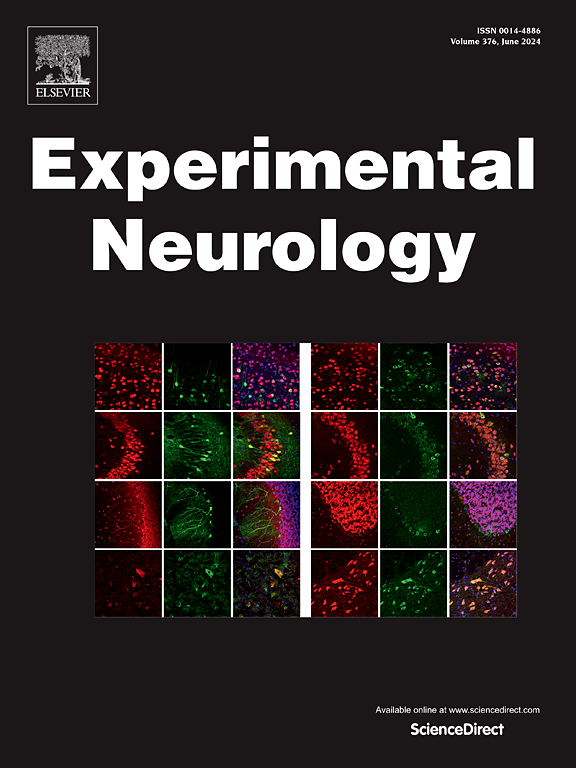调节 GABA 能系统作为治疗中风的一种选择。
IF 4.6
2区 医学
Q1 NEUROSCIENCES
引用次数: 0
摘要
中风是导致全球成人死亡和永久性残疾的主要原因之一。尽管在降低发病率和死亡率方面取得了进展,但与中风治疗相关的社会负担和治疗费用却在不断增加。大多数直接针对缺血性损伤的治疗方法都未能降低短期和长期的发病率和死亡率,因此仍需要更有效的治疗策略来促进卒中后的功能恢复。几十年来,脑卒中研究的重点一直是缺血急性期的过度兴奋和谷氨酸诱导的兴奋毒性及其与运动障碍的关系。最近,人们对脑卒中病理生理学的认识取得了进展,一些证据表明,通过γ-氨基丁酸(GABA)的主要抑制系统神经传递的变化在功能恢复中发挥着特别重要的作用,值得进一步关注。本综述概述了 GABA 能神经递质变化如何与中风恢复相关联,并概述了 GABA 能系统调节剂,特别强调了已被证明能影响中风发病机制或可塑性或防止认知功能下降的神经类固醇。报告还介绍了来自动物和人类临床研究的支持性证据,并讨论了针对中风的 GABA 信号疗法的潜力,以便将这一概念转化为人类神经修复疗法。年龄和性别被认为是与中风病理生理学相关的关键参数,也是开发治疗药物策略的重要因素。我们需要在未来的工作中加深对中风后神经化学变化的了解,扩展概念框架,并开发包括调节抑制系统在内的更有效的干预措施。本文章由计算机程序翻译,如有差异,请以英文原文为准。
Modulation of GABAergic system as a therapeutic option in stroke
Stroke is one of the leading causes of death and permanent adult disability worldwide. Despite the improvements in reducing the rate and mortality, the societal burden and costs of treatment associated with stroke management are increasing. Most of the therapeutic approaches directly targeting ischemic injury have failed to reduce short- and long-term morbidity and mortality and more effective therapeutic strategies are still needed to promote post-stroke functional recovery. Decades of stroke research have been focused on hyperexcitability and glutamate-induced excitotoxicity in the acute phase of ischemia and their relation to motor deficits. Recent advances in understanding the pathophysiology of stroke have been made with several lines of evidence suggesting that changes in the neurotransmission of the major inhibitory system via γ-Aminobutyric acid (GABA) play a particularly important role in functional recovery and deserve further attention. The present review provides an overview of how GABAergic neurotransmission changes correlate with stroke recovery and outlines GABAergic system modulators with special emphasis on neurosteroids that have been shown to affect stroke pathogenesis or plasticity or to protect against cognitive decline. Supporting evidence from both animal and human clinical studies is presented and the potential for GABA signaling-targeted therapies for stroke is discussed to translate this concept to human neural repair therapies. Age and sex are considered crucial parameters related to the pathophysiology of stroke and important factors in the development of therapeutic pharmacological strategies. Future work is needed to deepen our knowledge of the neurochemical changes after stroke, extend the conceptual framework, and allow for the development of more effective interventions that include the modulation of the inhibitory system.
求助全文
通过发布文献求助,成功后即可免费获取论文全文。
去求助
来源期刊

Experimental Neurology
医学-神经科学
CiteScore
10.10
自引率
3.80%
发文量
258
审稿时长
42 days
期刊介绍:
Experimental Neurology, a Journal of Neuroscience Research, publishes original research in neuroscience with a particular emphasis on novel findings in neural development, regeneration, plasticity and transplantation. The journal has focused on research concerning basic mechanisms underlying neurological disorders.
 求助内容:
求助内容: 应助结果提醒方式:
应助结果提醒方式:


